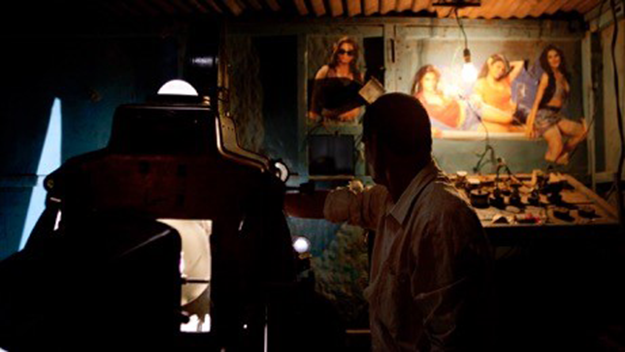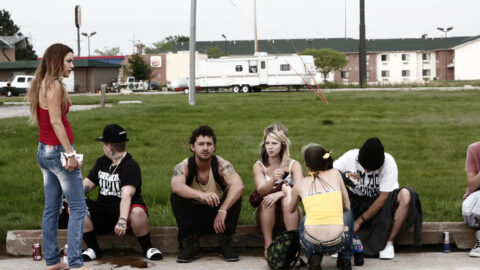Cannes Dispatch #5: Awards, Howards End, and The Cinema Travelers
The Salesman
Increasingly critical, and sometimes exhibiting a disconcerting lack of civility and respect, the journalists who cover the annual Cannes Film Festival expressed widespread dissatisfaction over the jury’s selection of winners last year, taking to social media or voicing their opinions aloud as last year’s event came to a close. Gathered in a massive cinema to watch a simulcast of the awards ceremony, attendees groaned in unison when Jacques Audiard’s Dheepan won the Palme d’Or, cinema’s most important international festival prize. The response forced jury co-president Joel Coen to remind the press, who were clearly pulling for other Competition entries: “This isn’t a jury of film critics, this is a jury of artists.”
Last night, as critics and writers sat down to watch this year’s ceremony, they were more expressive and even downright mean. When the cameras captured Xavier Dolan in the audience prior to the ceremony, a mob booed and moaned. Needless to say, minutes later when he was awarded the Grand Prix (effectively the festival’s runner-up award) for It’s Only the End of the World, the audience let him have it as they watched the video transmission of an emotional Dolan telling the jury, “Thank you for feeling the emotion of the film.” On Twitter, jury president George Miller was taken to task for leading the proceedings.
The crowd was a bit more respectful when Asghar Farhadi’s The Salesman won two awards (for Farhadi’s screenplay and actor Shahab Hosseini’s performance) and when Andrea Arnold was presented the Jury Prize for American Honey. But some booing was also heard.
I, Daniel Blake
Ken Loach’s I, Daniel Blake, a heartfelt advocacy piece decrying the mistreatment of the aging and less fortunate in our society, won the Palme d’Or this year, the second time that the British director was awarded the coveted trophy. While many were prognosticating that Maren Ade’s Toni Erdmann would win the big award, it was the nearly 80-year-old Loach who was instead celebrated. A persistent champion of working-class society, Loach seized the moment to draw attention to the themes explored in his touching new film, which depicts an aging British widower who, after a heart attack, falls into a bureaucratic tangle that threatens to send him into poverty and prevent him from getting the medical attention that he needs. “When there is despair, the people from the far right take advantage,” Loach said, after accepting his Palme d’Or from Mel Gibson. “We must say that another world is possible and necessary.”
Angry observers also catcalled Olivier Assayas when he took the stage last night. The French filmmaker and the Romanian Cristian Mungiu shared the directing prize for Personal Shopper and Graduation, respectively. During his remarks, Mungiu, a past Palme d’Or winner for 4 Months, 3 Weeks and 2 Days, reminded cinephiles to unify under the broad banner of art and independent film. “It’s really important to preserve diversity in cinema,” he said. “I have the impression that auteur cinema has often been relegated to a niche and I am grateful to the Festival de Cannes for making it possible for auteur cinema to exist.”
Howards End
Nearly 25 years ago, Howards End (92) was an unlikely hit at Cannes and later in theaters. The first film released by Sony Pictures Classics didn’t seem to have a lot going for it. Company co-president Tom Bernard revealed that the movie’s backers didn’t realize what they had on their hands and lacked faith in the picture. Sony grabbed it for a modest price, confident they would have a hit (and win awards) if they staged a slow rollout. The young company ended up keeping the Merchant Ivory movie in American cinemas for more than year. The film eventually received nine Academy Award nominations, winning three. “Sony Classics had the last laugh,” Anne Thompson wrote in Film Comment in 1993.
At the 45th Cannes Film Festival, almost a year before Oscar night, Howards End had an auspicious premiere. The film print broke early in the screening. It was repaired and restarted and then broke again.
Vanessa Redgrave, who was nominated for an Oscar for her performance as Ruth, matriarch of the Wilcox family and owner of the revered Howards End family home, stood up to make some remarks in French to give the projectionists a chance to fix the print. “Now, tonight we don’t have prints anymore,” director James Ivory said the other night at the Cannes Film Festival, introducing the 4K restoration of the film 24 years after its Cannes premiere. “There’s no such thing as prints, so it should be okay!”
Screening as part of Cannes Classics, a sidebar for restored movies and documentaries about filmmaking, Howards End is back, thanks to the restoration effort by Cohen Media Group, an American distribution company that has acquired 30 Merchant Ivory movies with a goal of resurrecting the brand. Known for lush British costume dramas, often adapted from well-known novels, Merchant Ivory was the company driven by the late producer Ismail Merchant and director James Ivory. Ruth Prawer Jhabvala wrote many of their films, Howards End included.
Howards End
A classic of the form, Howards End is a slow-burn, sharply drawn British romantic drama about three Edwardian-era families—the Schlegels, the Wilcoxes, and the Basts—starring Anthony Hopkins, Emma Thompson, Helena Bonham Carter, and Redgrave. A study of turn-of-the-century class and manners, the story unfolds as various members of each family meet and navigate increasingly complex interpersonal relations, as well unique connections to a storied home outside of London.
The film’s lush rural cinematography and memorable classical score shine in the new 4K restoration. “It’s all about making this available for those that remember this movie for what it was and for a whole new audience to discover what it is and that’s what Cannes Classics and the Cannes Film Festival is all about,” Charles Cohen praised, introducing the screening alongside Thierry Frémaux.
As the lights went down, Redgrave, seated among cinephiles to watch the restored version, broke the silence to offer a few more words before the movie began: “I love that you all are here.”
The Cinema Travelers
A valentine to dark rooms filled with enthusiastic audiences and whirring film projectors, the Cannes Classics documentary The Cinema Travelers stirred warm feelings in the same theater that showed Howards End a few nights earlier. Shirley Abraham and Amit Madheshiya, the film’s two young directors from Bombay, spent eight years exploring the vibrant and now-fading world of makeshift cinemas that serve rural moviegoers in India. In this loving nonfiction portrait they capture wonder in the eyes of local attendees who gather in tents to watch movies together on a big screen.
“We almost went back in time because traveling cinemas are now consigned to history. Even mythology in a way,” said Abraham, sitting down for a conversation with FILM COMMENT alongside Madheshiya. “They were believed to have disappeared around the time of WWII, no one has heard about them after that.”
Abraham and Madheshiya reverentially photographed the aging film projectors operated by the equally fragile-looking older projectionists who run the shows. Many of the men are seen eating and sleeping in the booths, next to their projectors, where they unspool movies for enthusiastic crowds. These traveling cinemas emerged in the 1940s and grew out of religious fairs that drew large crowds of Indians. Today, though, the tradition is swiftly waning, as The Cinema Travelers depicts. “When you are watching a film in a traveling cinema you constantly hear the whirring of the projector, smell the lamps,” Madheshiya said. “People pass in front of the lamps. We didn’t think it would end so soon.”
The Cinema Travelers
Late in the film, digital projection is installed and the magic seems to be wearing off. In a particularly painful scene for any movie lover, an analog projector is destroyed and sold off for parts. The shock of its sudden death is emotional. “Movie consumption is digital now and hence so much more individualized,” explained Abraham, when asked how moviegoing is changing back home. “It is so much more personal even than a television.”
The filmmakers, who were supported by the Sundance Institute at various stages during their many years in production, said that they couldn’t have imagined a better place to unveil their passion project than here in Cannes, within its Classics section. “To come to Cannes with a film on cinema . . . we could not have dreamt of a better place,” Madheshiya said.
“It’s really the perfect home for the film,” Abraham agreed. “The story of the traveling cinemas has been lost to history. Or let us say, they have been denied a history. They have brought this experience of the movies to villages far away from standing theaters for more than 70 years now and there was nothing written about them in our narratives, in our stories of the evolution of cinema in India. And for this story to now have found a home here in this most sacred—call it temple or cathedral of cinema—place is just an incredible honor for us. It’s so heartening and gratifying.”













